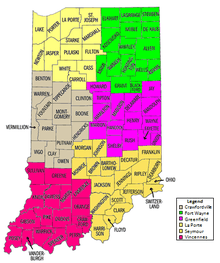Indiana Department of Transportation
 | |
| Agency overview | |
|---|---|
| Jurisdiction | Indiana |
| Headquarters | 100 N. Senate Avenue, Indianapolis, Indiana |
| Agency executive |
|
| Parent agency | State of Indiana |
| Website | http://www.in.gov/indot/ |
The Indiana Department of Transportation (INDOT) is a governmental agency of the U.S. state of Indiana charged with maintaining and regulating transportation and transportation related infrastructure such as state owned airports, state highways and state owned canals or railroads.
Indiana’s "highway network" started out as a series of dirt paths, which settlers created for local travel. Most of the time, these paths did not interconnect, making travel difficult at best.
When automobiles came on the scene in the late 19th century and early 20th century, people wanted better roads to travel. This interest was a national one, sparking the U.S. Congress to offer money to any state that would improve its roads. Indiana took Congress up on its offer and created the Indiana State Highway Commission (ISHC) in 1919. This Commission’s task was to create a highway network that would connect every county seat and every town with a population more than 5,000.
The Federal Aid Highway Act of 1956 established what is known today as the Interstate Highway System and signaled the beginning of the largest public works project in U.S. history. The act also established the Federal Highway Trust Fund, marking the first time that tax income from motor vehicles and highway expenditures were linked at the national level. The intent of the legislation was to make the highway program self-financing through the imposition of user fees.
A national highway safety program was initiated with the Federal-Aid Highway Act of 1966. The program established safety standards for motor vehicles and authorized matching grants to carry out safety activities.
The State Highway Commission served Hoosiers well until 1981 when it became the Indiana Department of Highways (IDOH). The Indiana Department of Highways also included the Office of Traffic Safety, the Toll Road Commission, and the Toll Bridge Commission.
On July 1, 1989 the Department of Highways underwent another change, combining the Department of Highways and the Transportation Planning Office to become the agency as we know it today—the Indiana Department of Transportation (INDOT).
In 1997, Governor Frank O’Bannon and the Indiana General Assembly started the Crossroads 2000 Program. This program invested $813 million in new highway construction projects across Indiana.
In late 2005, Governor Mitch Daniels launched an aggressive 10-year, $10 billion transportation plan, known as “Major Moves,” to significantly improve and expand Indiana’s highway infrastructure. A total of $2.6 billion was committed to Major Moves from the long-term lease of the Indiana Toll Road.
In addition to the Major Moves plan fund, INDOT benefited from the American Recovery and Reinvestment Act of 2009 (ARRA). Approximately $71 million of ARRA funds have been applied to Major Moves new construction, allowing for accelerated and adjusted Major Moves projects. Finally, no additional debt or increase in taxes has been incurred to complete Major Moves projects.
Sources: State Archives, INDOT Transportation Planning Office, Indiana State Library and State Board of Accounts
Districts

INDOT is divided into six districts for administrative purposes:[1]
| District | Sub-Districts | Counties |
|---|---|---|
| Crawfordsville | Cloverdale, Crawfordsville, Fowler, Frankfort, Terre Haute | Benton, Boone, Clay, Clinton, Fountain, Hendricks, Montgomery, Owen, Parke, Putnam, Tippecanoe, Vermillion, Vigo and Warren[2] |
| Fort Wayne | Angola, Bluffton, Elkhart, Fort Wayne, Wabash | Adams, Allen, DeKalb, Elkhart, Fulton, Grant, Huntington, Kosciusko, LaGrange, Miami, Noble, Steuben, Wabash, Wells, Whitley and parts of Jay and Blackford[3] |
| Greenfield | Albany, Cambridge, Greenfield, Indianapolis, Tipton | Delaware, Fayette, Hamilton, Hancock, Henry, Howard, Jay, Madison, Marion, Randolph, Rush, Shelby, Tipton, Union and Wayne[4] |
| LaPorte | Gary, LaPorte, Monticello, Plymouth, Rensselaer, Winamac | Carroll, Cass, Fulton, Jasper, Lake, LaPorte, Marshall, Newton, Porter, Pulaski, St. Joseph, Starke and White[5] |
| Seymour | Aurora, Bloomington, Columbus, Falls City (Clarksville), Madison | Bartholomew, Brown, Clark, Dearborn, Decatur, Floyd, Franklin, Harrison, Jackson, Jefferson, Jennings, Johnson, Monroe, Morgan, Ohio, Ripley, Scott, Switzerland and Washington[6] |
| Vincennes | Evansville, Linton, Paoli, Tell City, Vincennes | Crawford, Daviess, Dubois, Gibson, Greene, Knox, Lawrence, Martin, Orange, Perry, Pike, Posey, Spencer, Sullivan, Vanderburgh and Warrick[7] |
Lists of roads
| Interstate Highways: A list of Interstate Highways within Indiana. | |
| U.S. Routes: A list of U.S. Routes within Indiana. | |
| State Roads: A list of all state roads within Indiana. | |
| Former state highways: A list of former state roads within Indiana. |
External links
References
- ↑ Indiana Department of Transportation. "INDOT: Districts & Sub-Districts". Indiana Department of Transportation. Retrieved 2011-10-30.
- ↑ Indiana Department of Transportation. "INDOT: Welcome to the Crawfordsville District". Indiana Department of Transportation. Retrieved 2011-10-30.
- ↑ Indiana Department of Transportation. "INDOT: Welcome to the Fort Wayne District". Indiana Department of Transportation. Retrieved 2011-10-30.
- ↑ Indiana Department of Transportation. "INDOT: Welcome to the Greenfield District". Indiana Department of Transportation. Retrieved 2011-10-30.
- ↑ Indiana Department of Transportation. "INDOT: Welcome to the LaPorte District". Indiana Department of Transportation. Retrieved 2011-10-30.
- ↑ Indiana Department of Transportation. "INDOT: Welcome to the Seymour District". Indiana Department of Transportation. Retrieved 2011-10-30.
- ↑ Indiana Department of Transportation. "INDOT: Welcome to the Vincennes District". Indiana Department of Transportation. Retrieved 2011-10-30.
